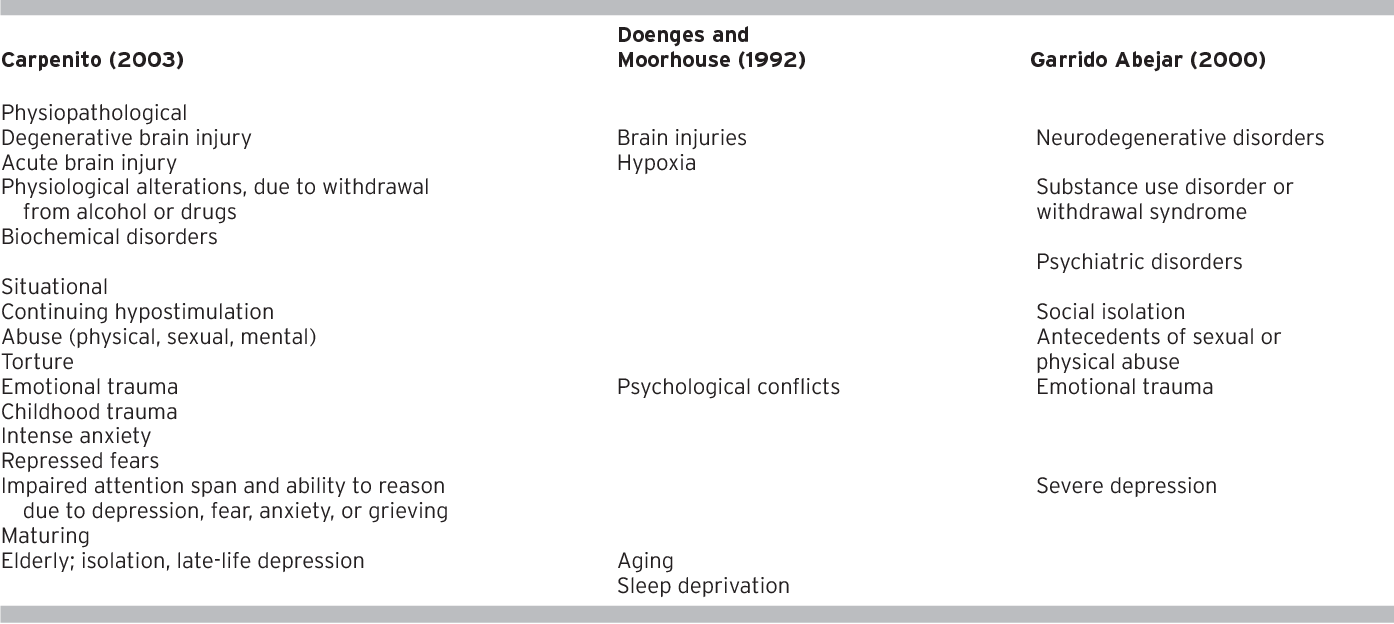Have you ever felt like your thoughts were racing, jumbled, or even disconnected? Perhaps you’ve struggled to concentrate, or found yourself becoming overwhelmed by intrusive or negative thoughts? These experiences can be intensely distressing, and for some, they can be a sign of a complex mental health condition. The nursing diagnosis of Disturbed Thought Processes, according to the North American Nursing Diagnosis Association (NANDA), provides a framework for understanding and addressing these very challenging mental health experiences.

Image: www.semanticscholar.org
This article will delve into the intricacies of Disturbed Thought Processes, exploring its defining characteristics, associated factors, and the essential nursing interventions that can guide individuals towards greater mental clarity and well-being. By shedding light on this crucial nursing diagnosis, we aim to empower both individuals experiencing these challenges and those who care for them with invaluable knowledge and practical strategies.
Disturbed Thought Processes: A Deeper Dive into the NANDA Framework
The NANDA definition of Disturbed Thought Processes encompasses a broad spectrum of cognitive disruptions that can significantly impact an individual’s daily life. It’s crucial to recognize that thoughts are not inherently good or bad; rather, it’s the pattern and impact of these thoughts that determine if they are considered ‘disturbed.’ This diagnosis centers on the individual’s subjective experience and the observable behavioral manifestations of their altered thinking.
Defining Characteristics:
The NANDA framework identifies several key characteristics that are often associated with Disturbed Thought Processes. These include:
- Disorganized thinking: This can manifest as difficulty following a train of thought, jumping between topics abruptly, or having thoughts that seem illogical or incoherent.
- Delusions: These are false beliefs held with strong conviction despite evidence to the contrary.
- Hallucinations: These are sensory experiences that occur in the absence of external stimuli, such as hearing voices or seeing things that aren’t there.
- Thought blocking: This refers to a sudden interruption in one’s train of thought, leaving the individual feeling blank or unable to continue.
- Tangential thinking: This involves straying off topic and losing focus on the original thought.
- Word salad: This refers to a jumbled collection of words and phrases that lack coherence or meaning.
- Flight of ideas: This is a rapid and continuous flow of thoughts that jump from one topic to another seemingly without connection.
- Circumstantiality: This involves excessive detail and digressions that make it difficult to follow the main point of the conversation.
- Perseveration: This involves repeating words, phrases, or actions inappropriately, often stemming from difficulty shifting to new ideas.
Associated Factors:
Disturbed Thought Processes can arise from a wide range of factors, both biological and psychosocial. These can include:
- Neurological conditions: Conditions like dementia, stroke, and traumatic brain injuries can affect cognitive function and lead to disturbances in thought.
- Mental health conditions: Anxiety disorders, depression, bipolar disorder, schizophrenia, and other mental health conditions often involve altered thinking patterns.
- Substance abuse: Alcohol and drugs can significantly disrupt brain function and induce cognitive impairment.
- Medication side effects: Certain medications can contribute to disturbances in thought processes, such as antipsychotics and some anti-depressants.
- Stress: Chronic or acute stress can overload the brain and lead to difficulty concentrating, racing thoughts, and difficulty making decisions.
- Sleep deprivation: Lack of adequate sleep can profoundly impair cognitive function and contribute to disorganized thinking and memory problems.
Nursing Interventions:
The goal of nursing interventions for Disturbed Thought Processes is to provide support, promote calmness, and facilitate improved cognitive function. Some crucial strategies include:
- Therapeutic communication: Establishing a safe and trusting environment is essential. Nurses can use active listening, empathy, and non-judgmental language to encourage the individual to express their thoughts and feelings.
- Reality orientation: Helping the individual stay grounded in reality, such as providing reminders of time, place, and person, can aid with orientation and reduce confusion.
- Cognitive behavioral therapy (CBT): CBT is often utilized to address distorted thoughts and help individuals develop healthier thought patterns and coping mechanisms.
- Medication management: Nurses play a vital role in administering prescribed medications, monitoring for side effects, and educating individuals about their medications.
- Stress reduction techniques: These can include relaxation techniques like deep breathing exercises, mindfulness meditation, and progressive muscle relaxation to promote calmness and reduce anxiety.
- Sensory modulation: Providing a calm and predictable environment with reduced stimuli can help manage sensory overload and promote cognitive clarity.
- Education and support: Providing education about the condition, its symptoms, and available resources can empower individuals and their families.
Expert Insights and Actionable Tips
Expert Advice:
Dr. Sarah Jones, a leading clinical psychologist specializing in cognitive disorders, emphasizes that “It’s crucial to approach Disturbed Thought Processes with compassion and understanding. Each individual’s experience is unique, and their needs will vary.” She stresses the importance of working collaboratively with the individual to develop personalized interventions that address their specific challenges.
Actionable Tips:
- Seek professional help: If you find yourself experiencing persistent or severe disturbances in your thinking, it’s essential to consult with a qualified mental health professional.
- Practice self-care: Prioritize sleep, exercise, healthy eating, and stress management techniques to support cognitive function.
- Engage in activities that promote relaxation and mindfulness: These can include activities like yoga, meditation, or spending time in nature.
- Educate yourself: Learning about Disturbed Thought Processes can help you to understand your experience better and to communicate your needs effectively.
![[PDF] The Nursing Diagnosis Disturbed Thought Processes: An Integrative ...](https://d3i71xaburhd42.cloudfront.net/5c36ef5c24804894d9fc70dc4dc9d97289faffcb/5-Table3-1.png)
Image: www.semanticscholar.org
Disturbed Thought Process Nursing Diagnosis Nanda
A Roadmap Towards Enhanced Cognitive Well-being
The nursing diagnosis of Disturbed Thought Processes sheds light on the complexity of cognitive experiences and highlights the vital role of nursing care in promoting mental well-being. Through a combination of expert support, evidence-based interventions, and personal empowerment, individuals can navigate the challenges of disrupted thinking and strive towards greater mental clarity and resilience. Remember, you are not alone on this journey. Reach out for help, embrace support, and believe in your ability to create positive change.




